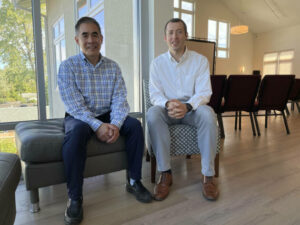Pastors question if they’ll unplug from online services after pandemic
Pastors Daniel Ying and Brad Bissell doubled as online TV preachers on YouTube during the coronavirus pandemic, preaching to video cameras and livestreaming into homes for months during the covid pandemic.
And like many pastors around the United States and around the world, Ying and Bissell are wondering how and when church life can transition back into real-life gatherings, with church members weaned off the safety and convenience of online church. Their decision on when to end online church is perhaps reminiscent of The Clash lyrics, “Should I stay or should I go now? … The indecision’s bugging me.”
“Remote worship was instrumental in allowing our church to continue through a pandemic,” said Ying, the senior pastor at Redeemer Montclair. “The downside is that it encourages a passive, spectator mentality over the long run.”

The challenge is that church members — particularly evangelical protestants in the U.S. — seem to enjoy techno church. A recent report from Infinity Concepts and Grey Matter Research that surveyed more than 1,000 evangelical Protestants in the U.S. found that 75% have attended online church during the pandemic.
“We found that 45% of those who experienced online church services now believe that worship online is equal or superior to the in-person experience,” said Mark Dreistadt, Infinity Concepts founder and president. And only 44% want to return exclusively to in-person worship, according to the report.
But some pastors know their parishioners are tempted to read the newspaper, check sports scores or play video games while listening to online church. Children might play with toys instead of attending Sunday school. And families might eat their breakfast while singing hymns and listening to the sermons in their pajamas.
Further worrying pastors, the report also found that many American evangelicals have used their homebound pandemic time to “digitally visit” churches other than their home church.
“One has to wonder whether this will ultimately lead to church nomads who surf the internet for new church experiences rather than putting down roots and becoming part of a church community,” said Ron Sellers, president of Grey Matter Research & Consulting.
Meanwhile, some churches fought back against forced online services, challenging now unconstitutional state mandates in court or ignoring such mandates altogether. Legal battles around religious exemptions continue around the U.S. including Kansas City where a suburban church successfully fought the county’s mandate in court and won with the county paying damages.
Data from Pew Research and Gallup shows in-person church attendance gaining ground and online attendance receding this past summer compared to 2020. Pew found that one quarter of U.S. adults overall say their faith has become stronger because of the coronavirus pandemic. But that still doesn’t help pastors know if and when they should turn off the webcams and streaming channels.
Bissell, the associate pastor at Redeemer Montclair, noted that online attendance for the church in northern New Jersey peaked at around 250 unique viewers via YouTube and settled to just over 100 for most of the pandemic. One online viewer who doesn’t normally attend the church gave a five-figure donation to the church’s building fund. The church also hosted small groups, prayer meetings and its youth group via Zoom. Even as state restrictions allowed in-person worship to resume, only 60% of the church members returned in person. And that concerns Ying and Bissell.
“Worship is something we do actively with our bodies — standing, kneeling, smelling, eating, drinking, singing — and together with the church,” Bissell said. “Screen entertainment is often done privately, on our sofas, with little to no physical engagement.”
His concerns about the downsides of worship by screen are echoed by pastors around the world. ReligionUnplugged.com heard from nearly a dozen pastors in Africa, Latin America, North America and Europe, most of whom expressed concerns about the long-term efficacy of online worship. Some pastors in Latin America said their churches are booming during the pandemic, gaining more viewers and attendees. Meanwhile, church leaders in Africa tended to worry that online church will create “lazy Christians” and lead to declining attendance.
The Rev. Dr. Grace Lubaale of Church of the Resurrection Bugolobi, Church of Uganda, said his own information technology skills improved along with parishioners during the pandemic, and he saw some new converts join the church in that time. But he considers the online era a net negative, as he also saw some people leave church or slide in their faith. He also said only 60% of his church members had Wi-Fi connectivity, which limited participation.
“People should worship together as in Acts 2:42-47,” he said, adding that virtual worship “cannot be a permanent position, or the church will end.”
Innovation From Africa to Long Island
Meanwhile, Derrick Kaddu, a spokesman for the Anglican diocese in Mukono, Uganda, said only 40% of the 400,000 Anglicans in the rural area of 1 million people can afford some kind of internet service.
Kaddu said the Sts. Philip and Andrews Cathedral where he attends managed by streaming live on Facebook and broadcasting two Sunday services via a local radio station called Mukono Broadcasting Services 89.8 FM. He said his church also installed loudspeakers at every church in his diocese “to narrowcast the gospel to the nearby members of the community during the lockdown.”
Yet his church’s innovations still brought financial pain as offering revenues dropped, and the diocese may have to lay off staff members. He said only 30% of his flock has returned as the pandemic eases.
“We shall go on with the virtual church,” he said. “The younger generation wants it. People don’t want to go to church anymore. They want to remain online and attend services from their homes. But we need to find new ways of generating income for the church outside offertory.”
Veronica K. Masinde, pastor of Bethel Covenant Connection Ministries, a Pentecostal church in Kampala, Uganda, said her church had never livestreamed before the pandemic but began posting recorded videos online and on the church’s WhatsApp group during the pandemic. It then started livestreaming its services via Facebook and YouTube and continues to do so.
Church staff also called people by phone to check on them and their families and shared inspirational messages and devotionals with church members via WhatsApp.
Technological church “takes away the effect of corporate worship and the joy of gathering together and physically connecting,” Masinde admitted, noting that 90% of her church members have internet connections to watch the service live or recordings afterward. She said they miss out as online offerings “create detachment with time.”
Even the New York Times found online worship was detrimental to faith.
Regardless, Masinde is emphatic that online church is too powerful an opportunity to shelve completely. “The virtual option shall remain until the world comes to an end,” she said. “The pluses for us include expanding to a bigger audience. We are an international church, and we have to keep our congregants across the board well engaged.”
Henry Fuhrman and Jerry O’Sullivan — pastors at Shelter Rock Church in Nassau County, New York, on the north shore of Long Island — said their church streamed messages via Facebook before the pandemic but started offering more robust online services in March 2020 using the Church Online platform and a livestream via Life Church. They prerecord their messages to avoid technical snags and added in live chat and live prayer support by fall.
Fuhrman, the senior pastor at Shelter Rock, said an average of 850 people attended the online campus between October 2020 and April this year before shifting back toward in-person church in the spring. He said roughly two-thirds of the church is now attending live services at its Long Island campuses. Yet more than 1,000 believers still watch services online each week. This isn’t a uniquely American phenomenon.
The church saw online giving rise dramatically during the pandemic and remain strong ever since. Another bright spot was that some seekers “found the church online and eventually made it to an in-person service who had not attended the church prior to the pandemic,” O’Sullivan said.
At the same time, he saw some church members struggling during the pandemic because they lacked “personal encouragement, accountability and community.” So the church hired an online pastor who could reach out to people in new ways.
“We are dealing now with many who are coming back to in-person services who are far from God and struggling in their marriages and relationships because of a lack of intimacy and connection with God and others,” O’Sullivan said. Yet his church won’t give up on digital services.
This past Sunday, Shelter Rock’s overall attendance of 2,300 was 40% higher than pre-pandemic levels, matching indicators that the church grew significantly during the pandemic, according to Fuhrman. “We have no plans of getting rid of online church,” Fuhrman said. “We are reaching people we couldn’t reach before. I think it’s the new front door.”
To Unplug? Or Stay Wired for Worship?
Ying and Bissell at Redeemer Montclair said their church plans to continue its livestream for the foreseeable future, albeit with hopes that more members and visitors will resume in-person attendance as the pandemic becomes history rather than present reality.
They reflected on the pandemic effects on a recent weekday, sitting in a clean, light-filled sanctuary in the upstairs of a new addition to the church that was completed during the pandemic.
“Opting for virtual worship occasionally for special circumstances can be edifying,” Bissell said earlier, in an email. “As a replacement for regular in-person worship, I believe it harms people. We are commanded to not give up meeting together (Hebrews 10:25). How can we love one another, bear one another’s burdens, or encourage one another if we do not gather with one another?”
Yet he and Ying admit they haven’t had any discussions of turning off the online services. The services have enabled parents who are home sick with children to tune in to church. Digital giving has increased dramatically.
Ying said he worries that families have a hard time retaining worship when viewing church from home. He’s not sure how many, if any, people sing along to worship songs from home. He laughed, recalling what one child exclaimed to a parent when the church service came on YouTube: “Not this show again!”
The pastors at Redeemer Montclair have noticed that in-person attendees often mention the live music in worship is much more impactful and high-quality than when delivered via screen — no matter how good a surround sound system a home viewer may have.
The church serves communion in prepackaged, plastic-wrapped container kits that include a small cup of grape juice to symbolize Christ’s blood and a wafer to symbolize Christ’s body. Many in-person attendees still sit in socially-distanced fashion and wear face masks during the service. And the pastors have noticed that making their church bulletin available via QR codes and email links can save $14,000 in printing costs each year.
If Redeemer Montclair ever does chose to turn off its YouTube livestream because viewership is low, it would be a decision of the elders. The Presbyterian Church in America, as a denomination, has encouraged its member churches to look for a silver lining in the pandemic, Ying said. And he has.
“The livestream is a lifeline for our church family,” he said. “It’s become such a feature now, it would be hard to go back.”
Note to readers: A shorter version of this piece was originally published in the Houses of Worship column at The Wall Street Journal. Also, as a disclosure, Glader attends Redeemer Montclair.
Paul Glader is executive editor at ReligionUnplugged.com and a professor of journalism at The King’s College in NYC, where he directs the McCandlish Phillips Journalism Institute. He spent 10 years as a staff writer at The Wall Street Journal and has also reported for The Washington Post, The Associated Press, Forbes.com and many other publications.
John Semakula is a Kampala-based reporter for New Vision, Uganda’s leading daily newspaper, and is an alumnus of The Media Project’s coaching and leadership fellowship at the Poynter Institute in Florida. His reporting from Uganda contributed to this story.







